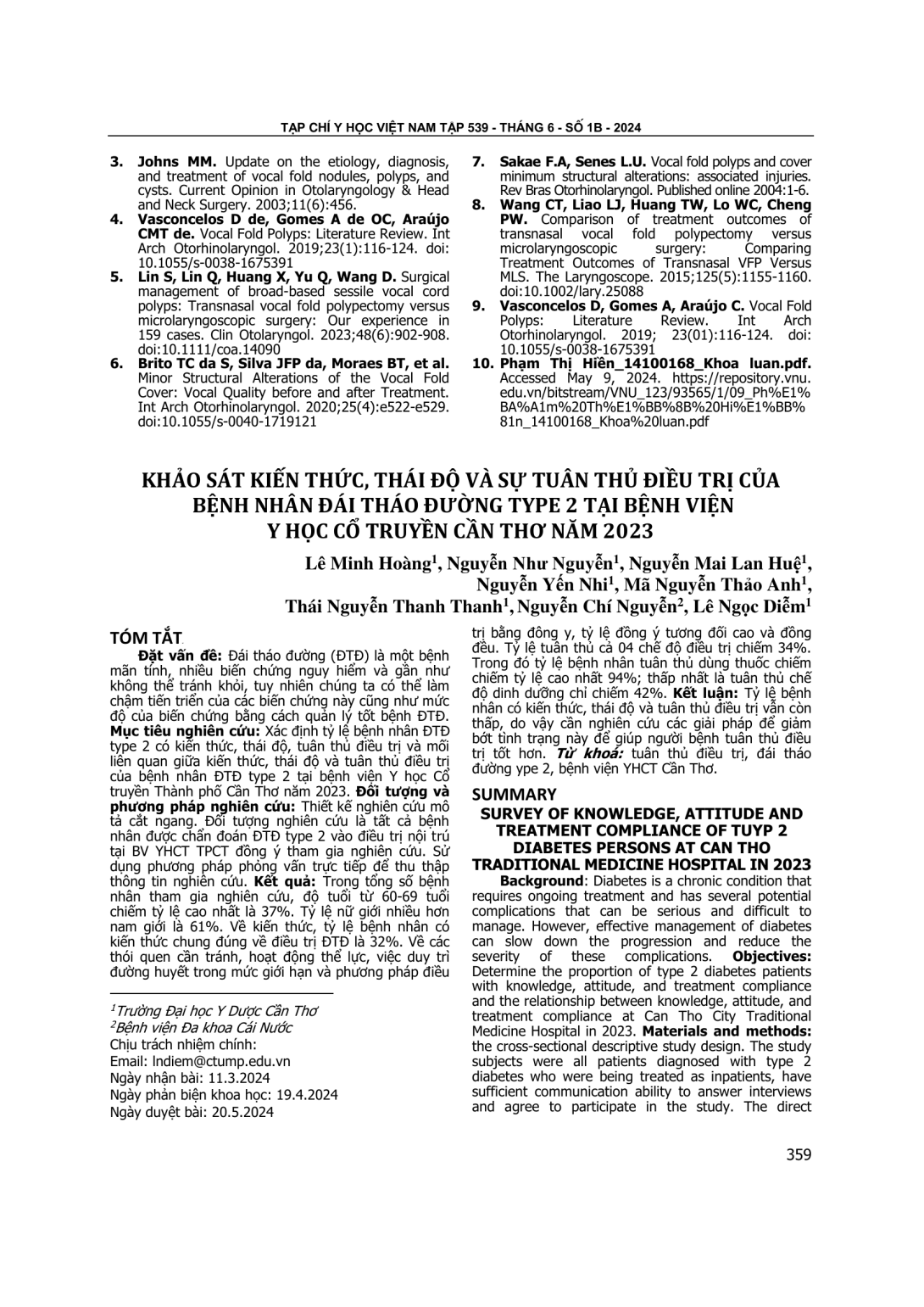
Xác định tỷ lệ bệnh nhân ĐTĐ type 2 có kiến thức, thái độ, tuân thủ điều trị và mối liên quan giữa kiến thức, thái độ và tuân thủ điều trị của bệnh nhân ĐTĐ type 2 tại bệnh viện Y học Cổ truyền Thành phố Cần Thơ năm 2023. Đối tượng và phương pháp nghiên cứu: Thiết kế nghiên cứu mô tả cắt ngang. Đối tượng nghiên cứu là tất cả bệnh nhân được chẩn đoán ĐTĐ type 2 vào điều trị nội trú tại BV YHCT TPCT đồng ý tham gia nghiên cứu. Sử dụng phương pháp phỏng vấn trực tiếp để thu thập thông tin nghiên cứu. Kết quả: Trong tổng số bệnh nhân tham gia nghiên cứu, độ tuổi từ 60-69 tuổi chiếm tỷ lệ cao nhất là 37%. Tỷ lệ nữ giới nhiều hơn nam giới là 61%. Về kiến thức, tỷ lệ bệnh nhân có kiến thức chung đúng về điều trị ĐTĐ là 32%. Về các thói quen cần tránh, hoạt động thể lực, việc duy trì đường huyết trong mức giới hạn và phương pháp điều trị bằng đông y, tỷ lệ đồng ý tương đối cao và đồng đều. Tỷ lệ tuân thủ cả 04 chế độ điều trị chiếm 34%. Trong đó tỷ lệ bệnh nhân tuân thủ dùng thuốc chiếm chiếm tỷ lệ cao nhất 94%; thấp nhất là tuân thủ chế độ dinh dưỡng chỉ chiếm 42%. Kết luận: Tỷ lệ bệnh nhân có kiến thức, thái độ và tuân thủ điều trị vẫn còn thấp, do vậy cần nghiên cứu các giải pháp để giảm bớt tình trạng này để giúp người bệnh tuân thủ điều trị tốt hơn.
Determine the proportion of type 2 diabetes patients with knowledge, attitude, and treatment compliance and the relationship between knowledge, attitude, and treatment compliance at Can Tho City Traditional Medicine Hospital in 2023. Materials and methods: the cross-sectional descriptive study design. The study subjects were all patients diagnosed with type 2 diabetes who were being treated as inpatients, have sufficient communication ability to answer interviews and agree to participate in the study. The direct interview method was used to collect research information. Results: Of the total number of patients participating in the study, the number of patients aged 60-69 years accounted for the highest proportion of 37%. The proportion of women is 61% more than men. Regarding knowledge, the proportion of patients with correct general knowledge about diabetes treatment is 32%. Regarding habits to avoid, physical activity, maintaining blood sugar within limits, and oriental medicine treatment, the agreement rate is relatively high and uniform. The compliance rate for all 4 treatment regimens is 34%. Among them, the rate of patients complying with medication accounts for the highest rate of 94%; The lowest is nutritional compliance, only 42%. Conclusion: The level of knowledge, attitude, and treatment adherence among the subjects is currently subpar, so it is necessary to research solutions to reduce this condition to help patients better adhere to treatment.
- Đăng nhập để gửi ý kiến
